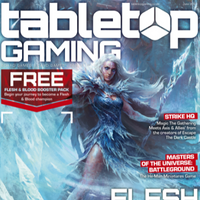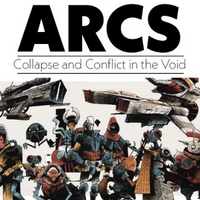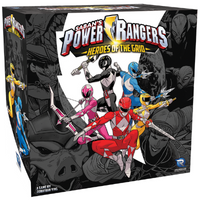10 September 2022
|
The War goes on with the Lord of the Rings game that sparked a love of Tolkein on the tabletop
Words by Ben Maddox
War of the Ring is a very special game. In fact, it is a very special work of art. Art has had a tricky time jumping between media. From interminable novelisations of rip roaring films and films ripping the guts out of much loved books. So often the gap between forms is so big that it’s impossible to leap. Then something special comes along. Something that is able to retain all of the magic of its former form while acquiring everything it needs to fulfil the needs of the new iteration. This is War of the Ring. A meticulously crafted paean to Tolkien and a relentlessly immersive ludological experience. It retains all of the wonder and tension of the story while achieving something that games do better than any other medium. Elucidating the needs and desires of all sides. Allowing the players to invest in their own victory regardless of the colour of the pieces they’re manipulating. Everything is here. The sprawling hordes consuming the ever dwindling lands of the free. The courageous final warriors, fighting to the last to save, not just lives, but a way of life, an ethos, a spirit and wandering through all of this tumult, a small band, so fragile, so vulnerable. The weakest part of the free forces is the key to its victory. Open this box and what leaps out is The Lord of the Rings.

A LONG-EXPECTED PARTY
The fact that this game ever got made though is a story of courage. A story of sticking to one’s principles and a story of the underdog fighting for what they believe in and coming through in the end. In fact, it’s very much a hobbit story.
The crumbling grandeur of Venice couldn’t be further away from the bucolic undulations of The Shire but it is here that War of the Ring was born.
“We grew up on those books,” says Francesco Nepitello, one of the designers of the game. He grew up in the narrow streets of Venice and immersed himself in the rolling hills and endless deeps of Middle-earth but it did, initially, take him a while to get through the books and if it wasn’t for an adolescent dose of the flu the game might never have existed.
“I felt sick and stayed home for a week and decided, right, I’m going to get through this thing,” the designer tells me.
In Britain we see Tolkien as one of the great pillars of 20th Century British literature. A universal story that transcends anything as petty as political division. In Italy in the late seventies though, the climate was very different. Nepitello remembers the tensions at that time.
“We had a strange situation here in Italy where, especially in the seventies,” he explains, “there was this cultural clash between the right wing people and the left wing where the right adopted Tolkien as one of the intellectuals that was right wing.”
Italy’s nascent neo-facist movement, The Youth Front, an organisation that had turned the Italian right upside down with it’s much more active and violent approach to far-right activism had adopted Tolkien’s work as a rallying point, a clarion call for a past that had never existed. They even named their 1977 festival, Campo Hobbit.
“And it’s funny because if you go to the states for example, it’s pretty much the opposite. Tolkien was adopted by the hippie movement. For decades, if you read Tolkien, you could be considered to be right wing.”
Of course for the 11 year old Nepitello such ludicrous interpretations couldn’t be further from his mind and he soon folded his love of Tolkein in with his other great preoccupation, gaming.
“I have two brothers, an elder brother and a younger one…very early on we started developing games with rules.”
The Peter Jackson adaptations of the Lord of the Rings novels flushed Tolkien out of the murky world of Italian sectarianism into the glare of mainstream adoration. Even encouraging Italy’s 53rd prime minister, Massimo D’Alema, to sheepishly admit that he had covertly read them in his youth.
“I remember that the secretary of the main left wing party in Italy admitted on TV that he read The Lord of the Rings secretly when he was in college because he couldn’t admit it to the comrades that he was reading Tolkien,” says Nepitello “luckily this is behind us even if, still, right wing parties like to remind people of their opinion that Tolkien was right wing.”
The time had come for an all encompassing game to be produced.
Nepitello, in the intervening years, after toying with the idea of entering the movie business had found his feet as a game designer. He’d already had an RPG published and was working closely with fledgling Italian publisher Nexus Games, the forerunner of War of the Ring’s current publisher, Ares Games. His proficiency at English made him an indispensable addition to the team when they would make their annual pilgrimage to Spiel in Essen, the world’s biggest game fair. It would be coming back from one of these trips he would put his head together with his fellow designers on the game, Roberto Di Meglio and Marco Maggi and start to formulate ideas.
“During our trips to Germany we started talking about games and Tolkien and the things we’d like to do,” says the designer.
They drew mechanical inspiration for the game from the war games that they were playing.
“At the time we were playing Paths of Glory by GMT and we were so enamoured by the card driven system that we’d already seen in Hannibal before and we were fantasising about itm” says the designer, “‘it would be so good to have a game that used this type of mechanic’ we said – because card driven games can combine the strategy elements of the story and the story. So, we said this could be perfect for a Lord of the Rings game because we could have all the elements together from the characters to the armies.”
They could talk and formulate all they wanted though, without the licence there would be no game. To get it they would have to audition and their little company would find themselves up against some of the biggest players in games at that time.
Enter Robert Hyde of UK company, Sophisticated Games. He was the one with the right to confer the licence on the company that he considered most suitable to create the game. To find the right fit he would travel around the world, meeting with companies that had far bigger budgets and far greater resources than Nexus.
“Sophisticated Games told us you are among four or five companies that are interested in doing that. You have to remember at that moment the first movie from the Peter Jackson trilogy was out and so, of course, everyone was interested in making games from The Lord of the Rings… There was Fantasy Flight, Eagle Games, Phalanx, so several big companies and some of them brought some really good assets…one company has a fantastic map done by a really big artist.”
Still, undeterred by any potential competition, Nexus contacted Robert Hyde and he agreed to meet with them.
“We had a month to congeal our ideas into something playable,” says Nepitello, and the team began pulling these ideas out of their heads and onto the table. Thankfully Robert Hyde, “always had quality in mind,” and appreciated the modest, game focused approach of the Italian company.
“It was such a humble presentation because Nexus was such a small company and we were in a flat…using a very simple, non-professional prototype. Using plastic chips for the figures and so on. But we must have done something right because Robert liked it. Robert liked it so much that he preferred our game to the proposals by Fantasy Flight and Eagle Games, of course we were over the moon with this. Robert took quite a bet on this because he preferred something coming from an almost unknown company compared to Fantasy Flight or Eagle Games.”
Now they just had to design the game, “the pressure was huge.”
They had one valuable resource they could use though, supreme confidence in what they were doing.
“I remember we were playtesting and every time we finished we said ‘This game is fantastic!’,” says the designer.
They also had the gigantic Tolkien community to help them out. Chipping in their feedback in a year long playtesting process. Thousands of games were played and the game was endlessly changed and iterated. The goal was to make the game as elegant as possible while keeping the feel and spirit of the books. When they came to the end of the design process they were sure they had done everything they could.
“We saw we had something really good in our hands,” explains Nepitello. So good, in fact, that those who had lost out to Nexus in the bidding process were eager to distribute the game internationally. Christian Petersen, head of Fantasy Flight Games, quickly overcame his disappointment and became the game’s North American distributor.
“Christian is an excellent designer and a huge Tolkien fan. He really wanted to design the game but as much as he is an enthusiast he is also a professional and veteran publisher. The minute after he received the information that we had been given the licence to do the game he wrote us immediately, saying ‘Okay, congratulations, you know I really wanted to do that game but we are absolutely the best partner you can have in the international market.’ He was so professional, so immediately there.”
With everything in place the game just had to be released.

RETURN OF THE KING
“The game was immediately a success,” says Nepitello, but the designer is keen to caveat that statement. War of the Ring was very much a hobby success. It wasn’t dealing in the kinds of numbers that juggernauts like Catan and Ticket Ride deal in but, for a game of such breadth and complexity, it has achieved impressive, and most importantly, consistent sales.
War of the Ring has been selling steadily from 2004 until now. And with periodic expansions, War of the Ring has remained the definitive Tolkien experience in board game form.
What about the future though? A second edition cleaned up graphic design and component issues but he doesn’t see that an awful lot can be done to improve the gameplay.
“We are in that situation where the game is a classic so it’s very hard to look at it and think what you can change because you might go wrong. You might move something that people actually love and that makes the game so persistent in its success. What shall we do to make the game better?”
Still, the second edition was produced before quality miniatures in board games became the standard rather than the exception. Will there be a third edition with better componentry?
“For sure we can improve physical stuff,” says Nepitello, “the standard of the figures for example, is not the standard of today. This is something we will probably do.”
This won’t be a great overhaul of the game though, “you shouldn’t fix something that isn’t broken.”
There is one important question that remains to be answered though. What does he think Tolkien would think of his work? Though he dodges the question expertly he does say something that gives an insight into why the game works so well.
“We grew up with those books and we always spent such an unreasonable amount of time musing about it,” says the designer, “we were really breathing the mood of The Lord of the Rings all the time and so when we were there doing what was, at the time, our dream assignment we put everything we had matured within ourselves as a comprehension of the books…We avoided doing anything that we thought would remotely offend the spirit of Tolkien.”
It is this lifelong love of the material and this central idea, that the spirit of Tolkien is sacrosanct, that makes War of the Ring the experience that it is. There is not only an expert understanding of what makes a good game but a respect and reverence for Tolkien’s world. A respect and reverence that bursts out of every card and shimmers out of every mechanism. War of the Ring is a game that is so wedded to its theme that without it there would be no game and, it seems, that Francesco agrees.
“Would this game be as good if it wasn’t The Lord of the Rings? I think it’s a pretty silly question.”
Looking for more?

This review came from Tabletop Gaming Magazine, which is home to all of the latest and greatest tabletop goodness. Whether you're a board gamer, card gamer, wargamer, RPG player or all of the above, find your copy here.
Get your magazine hereRead More...

If you want to read more about one of the most hotly anticipated games of the year, check out our interview with Cole Wehrle on ARCS! A new game from the designer of Root and Oath, and we've got all you need to know.
To infinity and beyond
Join us in person

We can't wait for Tabletop Gaming Live 2022! An epic weekend in Manchester full of board games, card games, roleplaying games, wargames and more, with amazing exhibitors, great games, and an opportunity to game together in person.
See you there!Treat Yourself!

Have you visited our game store? We have everything from mystery boxes, to games and accessories – including the above Power Rangers: Heroes of the Grid, with a great discount! Head over to find your new favourite game.
Visit the Game Store
Sometimes we may include links to online retailers, from which we might receive a commission if you make a purchase. Affiliate links do not influence editorial coverage and will only be used when covering relevant products







